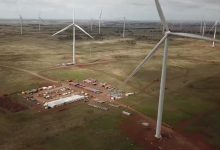Victoria continues to attract “very, very strong global interest” from renewable energy investors, according to state energy minister Lily D’Ambrosio, despite the state’s significant and ongoing network challenges.
In an interview with RenewEconomy following news of the state’s second VRET auction earlier this week, D’Ambrosio said a round-table meeting with more than 300 global investors on Wednesday night had demonstrated a strong appetite for further investment in the state.
D’Ambrosio says attendees of the online meeting were “very eager to hear the next steps” for Victoria, which she said was highly regarded by global investors for its “strong, ambitious renewable energy targets … (and) extremely well-designed reverse auction process.”
Victoria on Wednesday announced plans for a second such auction, VRET2, with the goal of procuring a minimum of 600MW of new solar and wind energy capacity – enough to power the state’s hospitals, schools and train network, among other things.
The new auction process – which D’Ambrosio said would be formally launched in “coming weeks” – has been welcomed by industry and green groups, but has also raised concerns around how the state’s grid will accommodate another 600MW+ of large-scale solar and wind when it is struggling to connect and fully commission capacity procured in the first VRET round.
Victoria’s grid congestion and instability issues have been concentrated in the state’s West Murray region, where five solar farms had their output cut in half for more than seven months, and the 336MW Dundonnell wind project has been stopped in its tracks by network issues that have not been fully revealed.
There are also concerns that the curtailments already imposed on the so-called “rhombus of regret”, a weak part of the grid, may be extended further into the state.
In comments to RenewEconomy, D’Ambrosio recognised the pressing need for the state to work with the Australian Energy Market operator to fix these “bottleneck” issues, and said the government would have more to say on the matter “in due course.”
“The reality is that there are significant network challenges right across the system. I personally have been working very closely with the market operator to identify possible solutions to help unlock the capacity for renewable energy to come online,” the minister said.
“We do need an electricity network that is ready and primed to unlock all of the natural resources that we have in Victoria so that we are able to facilitate new investment decisions.
“In this period of market sounding, we’ll be considering options in terms of dispatchable generation potential and take into full consideration matters of grid location and grid constraints,” she said.
“What is important is that the ISP (Integrated System Plan) released by AEMO last month made some very clear decisions around projects that needed to be built.”
One of these, and perhaps the most pressing, is the development of the new Victoria to New South Wales Interconnector West, or VNI West, that will allow renewable generation to be transferred between the two states.
D’Ambrosio said transmission solutions such as VNI West were “vital” to the state’s renewable energy transition, and that Victoria was strongly backing this particular project. But she also noted that there were other options – including near-term fixes – that could also be implemented.
“I’m very confident that …(there will be) some nearer-term solutions that will be deployed. Not everything is about transmission upgrades. … Other options will focus on fixing system strength issues and building Renewable Energy Zones,” the minister said.
“Our commitment is to move as quickly as we can. We know these projects are a vital component of our economic stimulus (post-Covid). They are also very popular projects and ones that we want to see built.
“We need to continue to increase the new sources of energy supply because we know that we just can’t rely on the existing ageing thermal generators,” D’Ambrosio added.
“As they age they are becoming less reliable. But we are already a few thousand megawatts better off this summer compared to last summer.”










